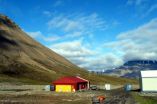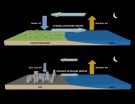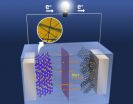(Press-News.org) If a person's blood becomes too thick it can damage blood vessels and increase the risk of heart attacks. But a Temple University physicist has discovered that he can thin the human blood by subjecting it to a magnetic field.
Rongjia Tao, professor and chair of physics at Temple University, has pioneered the use of electric or magnetic fields to decrease the viscosity of oil in engines and pipelines. Now, he is using the same magnetic fields to thin human blood in the circulation system.
Because red blood cells contain iron, Tao has been able to reduce a person's blood viscosity by 20-30 percent by subjecting it to a magnetic field of 1.3 Telsa (about the same as an MRI) for about one minute.
Tao and his collaborator tested numerous blood samples in a Temple lab and found that the magnetic field polarizes the red blood cells causing them to link together in short chains, streamlining the movement of the blood. Because these chains are larger than the single blood cells, they flow down the center, reducing the friction against the walls of the blood vessels. The combined effects reduce the viscosity of the blood, helping it to flow more freely.
When the magnetic field was taken away, the blood's original viscosity state slowly returned, but over a period of several hours.
"By selecting a suitable magnetic field strength and pulse duration, we will be able to control the size of the aggregated red-cell chains, hence to control the blood's viscosity," said Tao. "This method of magneto-rheology provides an effective way to control the blood viscosity within a selected range."
Currently, the only method for thinning blood is through drugs such as aspirin; however, these drugs often produce unwanted side effects. Tao said that the magnetic field method is not only safer, it is repeatable. The magnetic fields may be reapplied and the viscosity reduced again. He also added that the viscosity reduction does not affect the red blood cells' normal function.
Tao said that further studies are needed and that he hopes to ultimately develop this technology into an acceptable therapy to prevent heart disease.
Tao and his former graduate student, Ke "Colin" Huang, now a medical physics resident in the Department of Radiation Oncology at the University of Michigan, are publishing their findings in the journal, Physical Review E.
###
NOTE: Copies of this study are available to working journalists and may be obtained by contacting Preston M. Moretz in Temple's University Communications Office, 215/204-4380 or pmoretz@temple.edu.
Using magnets to help prevent heart attacks
Magnetic field can reduce blood viscosity
2011-06-08
ELSE PRESS RELEASES FROM THIS DATE:
Carbon release and global warming now and in the ancient past
2011-06-08
The present rate of greenhouse carbon dioxide emissions through fossil fuel burning is higher than that associated with an ancient episode of severe global warming, according to new research. The findings are published online this week by the journal Nature Geoscience.
Around 55.9 million years ago, the Earth experienced a period of intense global warming known as the Palaeocene–Eocene Thermal Maximum (PETM), which lasted for around 170,000 years. During its main phase, average annual temperatures rose by around 5°C.
Scientists believe that the warming may have been ...
Innovative device for quantum simulations
2011-06-08
A team of researchers from Columbia Engineering, the Italian National Research Council, Princeton University, University of Missouri, and University of Nijmegen (Netherlands) has developed an artificial semiconductor structure that has superimposed a pattern created by advanced fabrication methods that are precise at the nanometer scale. The pattern is similar to the honeycomb lattice that occurs in graphene. The device, called "artificial graphene" (AG), simulates quantum behavior of strongly interacting electrons. The research team sees the AG-device as a first step towards ...
Dolphins use double sonar
2011-06-08
Dolphins and porpoises use echolocation for hunting and orientation. By sending out high-frequency sound, known as ultrasound, dolphins can use the echoes to determine what type of object the sound beam has hit.
Researchers from Sweden and the US have now discovered that dolphins can generate two sound beam projections simultaneously.
"The beam projections have different frequencies and can be sent in different directions. The advantage is probably that the dolphin can locate the object more precisely", says Josefin Starkhammar, a newly examined doctor in Electrical ...
Will the eel survive its management?
2011-06-08
The European eel is on the way to disappearing for good. The species is critically endangered, and there are strong scientific arguments for suspending all fishing. Despite this situation, Swedish eel fishery is allowed to continue. Analysis of the eel management plan by the Swedish Institute for the Marine Environment identifies clear shortcomings. It is unlikely that Sweden will meet the target that has been set for silver eels capable of migrating back to the Sargasso Sea so that they can contribute to regeneration.
The recruitment of new annual cohorts of European ...
First of its kind study conducted by BUSM finds women as resilient to combat stress as men
2011-06-08
(Boston) - In what is believed to be the first published study on the topic, researchers affiliated with the Boston University School of Medicine (BUSM) believe female military service-members from Operation Enduring Freedom OEF)/Operation Iraqi Freedom (OIF) may be as resilient to combat-related stress as men. These findings currently appear on-line in the Journal of Abnormal Psychology.
Though the literature suggests that women may be more vulnerable to the effects of trauma exposure, most available studies on combat trauma have relied on samples in which women's combat ...
Red-light cameras critical to public safety, MU traffic researcher finds
2011-06-08
COLUMBIA, Mo. — As automated traffic monitoring systems such as red light cameras keep a law enforcement "eye" on the streets across the country, many drivers accuse city governments of installing the monitors as a way to generate revenue. New research from the University of Missouri says the safety benefits of automated traffic monitoring systems far outweigh the potential for abuse.
"A red light camera is not a panacea for traffic problems; it is a very effective tool for safe and efficient transportation," said Carlos Sun, an associate professor of civil engineering ...
Protein folding made easy
2011-06-08
Protein folding has nothing to do with laundry. It is, in fact, one of the central questions in biochemistry. Protein folding is the continual and universal process whereby the long, coiled strings of amino acids that make up proteins in all living things fold into more complex three-dimensional structures. By understanding how proteins fold, and what structures they are likely to assume in their final form, researchers are then able to move closer to predicting their function.
This is important because incorrectly folded proteins in humans result in such devastating ...
Paved surfaces can foster build-up of polluted air
2011-06-08
BOULDER—New research focusing on the Houston area suggests that widespread urban development alters wind patterns in a way that can make it easier for pollutants to build up during warm summer weather instead of being blown out to sea.
The international study, led by the National Center for Atmospheric Research (NCAR), could have implications for the air quality of fast-growing coastal cities in the United States and other midlatitude regions overseas. The reason: the proliferation of strip malls, subdivisions, and other paved areas may interfere with breezes needed to ...
The heat is on for sodium-manganese oxide rechargeable batteries
2011-06-08
RICHLAND, Wash. -- By adding the right amount of heat, researchers have developed a method that improves the electrical capacity and recharging lifetime of sodium ion rechargeable batteries, which could be a cheaper alternative for large-scale uses such as storing energy on the electrical grid.
To connect solar and wind energy sources to the electrical grid, grid managers require batteries that can store large amounts of energy created at the source. Lithium ion rechargeable batteries -- common in consumer electronics and electric vehicles -- perform well, but are too ...
Glaciations may have larger influence on biodiversity than current climate
2011-06-08
An investigation by the Spanish Scientifc Council (Consejo Superior de Investigaciones Científicas, CSIC) reveals that the large impacts occurred during the last ice age maintain their effects on the current distribution of dung beetles of the scarab family (Scarabaeidae). The presence of these beetles in Europe seems to be more influenced by the climate of that glaciation than by the present one.
The study, published yesterday in the journal Ecology Letters, analyzed the species richness and the structure of their communities throughout the different regions of the European ...
LAST 30 PRESS RELEASES:
Membrane magic: FAMU-FSU researchers repurpose fuel cells membranes for new applications
UN Member States pledge to increase access to diagnosis and inhaled medicines for the 480 million people living with COPD
Combination therapy shows potential to treat pediatric brain cancer ATRT
Study links seabird nesting to shark turf wars in Hawai‘i
Legal sports betting linked to sharp increases in violent crime, study finds
Breakthrough AI from NYUAD speeds up discovery of life-supporting microbes
New Eva Mayr-Stihl Foundation funding initiative boosts research at University of Freiburg on adaptation of forests to global change
The perfect plastic? Plant-based, fully saltwater degradable, zero microplastics
Bias in data may be blocking AI’s potential to combat antibiotic resistance
Article-level metrics would provide more recognition to most researchers than journal-level metrics
Satiety’s little helper: Protein that supports appetite regulating protein identified
UF dives deep into predicting storm damage with computer models
A stormy ocean voyage yields insights on the global carbon cycle
Scientists identify first non-coding gene that controls cell size
Demonstration of altermagnetism in RuO₂ thin films -- A new magnetic material for the AI era
Penn researchers awarded $25M to conduct trial using smartphones to fight heart disease
PCORI awards funding for new patient-centered healthcare research
Exploring the origins of the universe: 145 low-noise amplifiers complete ALMA telescopes
Empress cicada wings help illuminate molecular structure
Using sound waves to detect helium
Time burden in patients with metastatic breast and ovarian cancer from clinic and home demands
Researchers discover bias in AI models that analyze pathology samples
Scientists ID potential way to prevent brain injuries from triggering Alzheimer's
MASTER 2nd Open Call: Execution period kick-off
Algae for health in food and pharma
Advanced microrobots driven by acoustic and magnetic fields for biomedical applications
Chicago health information leader recognized for raising CPR readiness and blood pressure awareness
The Intimate Animal, a new book from Kinsey Institute Executive Director Dr. Justin Garcia
When blue-collar workers lose union protection, they try self-employment
New video dataset to advance AI for health care
[Press-News.org] Using magnets to help prevent heart attacksMagnetic field can reduce blood viscosity




